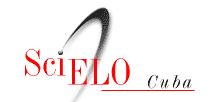Diagnóstico y tratamiento de los feocromocitomas y paragangliomas
Resumen
Palabras clave
Referencias
Fishbein L. Pheochromocytoma and paraganglioma: genetics, diagnosis and treatment. Hematol Oncol Clin North Am. 2016;30(1):135-50.
Young WF. Médula suprarrenal, catecolamina y feocromocitoma. En: Goldman L, Schafer AI. Goldman-Cecil Tratado de Medicina Interna. 25 Ed. Barcelona:Elsevier;2016. p. 380-99.
Almeida MQ, Bezerra JE, Mendonca BB, Latronico AC, Fragoso MC. Primary malignant tumors of the adrenal glands. Clinics. 2018;73(Suppl. 1):e756s.
Roman A, Jimenez C. Maligmant pheochromocytoma-paraganglioma: pathogenesis, TNM staging, and current clinical trials. Curr Opin Endocrinol Diabetes Obes. 2017;24(3):174-83.
Favier J, Amar L, Gimenez AP. Paraganglioma and phaeochromocytoma: from genetics to personalized medicine. Nat Rev Endocrinol. 2015;11(2):101–111.
Fishbein L, Leshchiner I, Walter V, Danilova L, Robertson AG, Johnson AR, et al. Comprehensive molecular characterization of pheochromocytoma and paraganglioma. Cancer Cell. 2017;31(2):181-93.
Neumann HP, Young WF, Eng CH. Pheocromocytoma and paraganglioma. New Eng J Med. 2019;381(6):552-65.
Hamidi O, Young WF, Gruber L, Smestad J, Yan Q, Ponce OJ, et al. Outcomes of patients with metastatic phaeochromocytoma and paraganglioma: A systematic review and meta-analysis. Clin Endocrinol. 2017;87(5): 440-50.
Eisenhofer G, Prejbisz A, Peitzsch M, Pamporaki C, Masjkur J, Rogowski-Lehmann N, et al. Biochemical diagnosis of Chromaffin cell tumors in patients at high and low risk of disease: Plasma versus urinary free or deconjugated O-methylated catecholamine metabolites. Clin Chem. 2018;64(11):1646-56.
Boyd J, Leung AA, Sadrzadeh HS, Pamporaki C, Pacak K, Deutschbein T, et al. A high rate of modestly elevated plasma normetanephrine in a population referred for suspected PPGL when measured in a seated position. Eur J Endocrinol. 2019;181(3):301-9.
Plouin PF, Amar L, Dekkers OM, Fassnacht M, Gimenez AP, Lenders JW, et al. European Society of Endocrinology Clinical Practice Guideline for long-term follow-up of patients operated on for a phaeochromocytoma or a paraganglioma. Eur J Endocrinol. 2016;174(5):G1–G10
Fassnacht M, Arlt W, Bancos I, Dralle H, Newell-Price J, Sahdev A, et al. Management of adrenal incidentalomas: European society of endocrinology clinical practice guideline in collaboration with the European network for the study of adrenal tumors. Eur J Endocrinol. 2016;175(2):G1–G34.
Naranjo J, Dodd S, Martin YN. Perioperative management of pheochromocytoma. J Cardiothorac Vasc Anesth. 2017;31(4):1427-39.
Livingstone M, Duttchen K, Thompson J, Sunderani Z, Hawboldt G, Rose MS, et al. Hemodynamic stability during pheochromocytoma resection: lessons learned over the last two decades. Ann Surg Oncol. 2015;22(13):4175-80.
van der Zee PA, de Boer A. Pheochromocytoma: a review on preoperative treatment with phenoxybenzamine or doxazosin. Neth J Med. 2014;72(4):190-201.
Siddiqi HK, Yang HY, Laird AM, Fox AC, Doherty GM, Miller BS, et al. Utility of oral nicardipine and magnesium sulfate infusión during preparation and resection of pheochromocytomas. Surgery. 2012;152(6):1027–36.
Brunaud L, Boutami M, Nguyen PL, Finnerty B, Germain A, Weryha G, et al. Both preoperative alpha and calcium channel blockade impact intraoperative hemodynamic stability similarly in the management of pheochromocytoma. Surgery. 2014;156(6): 1410-7.
Roman A, Zhou S, Ayala M, Shen C, Waguespack SG, Habra MA, et al. Impact of surgical resection of the primary tumor on overall survival in patients with metastatic pheochromocytoma or sympathetic paraganglioma. Ann Surg. 2018;268(1):172-8.
Ball MW, Hemal AK, Allaf ME. International consultation on urological diseases and european association of urology international consultation on minimally invasive surgery in urology: laparoscopic and robotic adrenalectomy. BJU Int. 2017;119(1):13-21.
Toniato A, Boschin IM, Opocher G, Guolo A, Pellizo M, Mantero F. Is the laparoscopic adrenalectomy for pheochromocytoma the best treatment? Surgery. 2007;141(6):723–7.
Nölting S, Grossman A, Pacak K. Metastatic phaeochromocytoma: spinning towards more promising treatment options. Exp Clin Endocrinol Diabetes. 2019;127(2-03):117-128.
van Hulsteijn LT, Niemeijer ND, Dekkers OM, Corssmit EP. (131)I-MIBG therapy for malignant paraganglioma and phaeochromocytoma: Systematic review and meta-analysis. Clin Endocrinol. 2014;80(4):487-501.
Sze WC, Grossman AB, Goddard I, Amendra D, Shieh SC, Plowman PN, et al. Sequelae and survivorship in patients treated with (131)I-MIBG therapy. Br J Cancer. 2013; 109(3):565-72.
Nastos K, Cheung VTF, Toumpanakis C, Navalkissoor S, Quigley AM, Caplin, M, et al. Peptide receptor radionuclide treatment and 131I-MIBG in the management of patients with metastatic/progressive phaeochromocytomas and paragangliomas. J Surg Oncol. 2017; 115(4): 425–434.
Ayala M, Chougnet CN, Habra MA, Palmer JL, Leboulleux S, Cabanillas ME, et al. Treatment with sunitinib for patients with progressive metastatic pheochromocytomas and sympathetic paragangliomas. J Clin Endocrinol Metab. 2012; 97(11):4040-50.
Enlaces refback
- No hay ningún enlace refback.
FINLAY EN: 








FINLAY CERTIFICADA POR:

Esta revista "no aplica" cargos por publicación en ninguna etapa del proceso editorial.
Dirección postal: Calle 51A y Avenida 5 de Septiembre Cienfuegos, Cuba Código postal: 55100.
http://www.revfinlay.sld.cu
Telefono: +53 43 516602. Telefax: +53 43 517733.
amgiraldoni@infomed.sld.cu
ISSN: 2221-2434
RNPS: 5129






